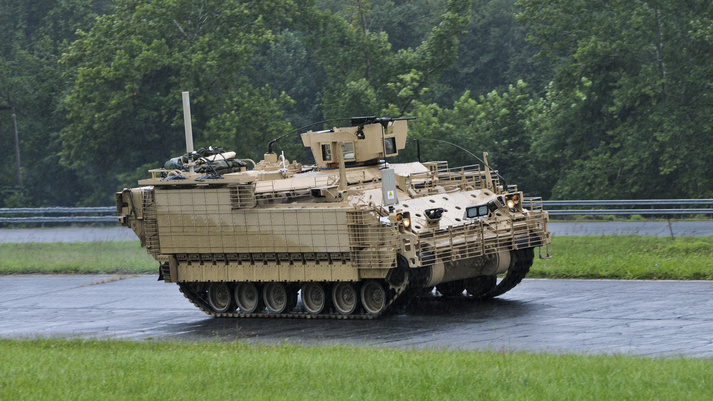
GP and MEV variants of the AMPV
Armoured Multi-Purpose Vehicle
The USA has begun the replacement of the old vehicles with
the Armored Multi-Purpose Vehicle (AMPV) project. The U. S. Army is currently
testing the new multi-purpose armoured vehicle for support missions. Developed
based on the M2/M3 BRADLEY, the mission carrier weighs 35 tonnes and can travel
at speeds of up to 60 km/h. Driver and commander are the standard crew. Five
versions are planned:
- General Purpose for up to six passengers with
remote-controlled weapon station, extensive radio equipment and, if necessary,
a stretcher for wounded persons, - Mortar carrier with 120 mm mortar, 69 rounds
ammunition supply, fire control system and radio equipment. - Armoured command tank for network-based
operations with two workstations for the operation of a red net. - Medical Evacuation for one paramedic and up to
six seated or lying wounded persons and - Medical Treatment for two paramedics, one lying
wounded.
At present, troops are testing 29 vehicles. This year, the
decision is to be made to start series production of 289 of the 3,000 vehicles
required.
The US Army also operates a large fleet of M113-series APCs,
but these no longer have sufficient mobility or protection to operate with the
M2 Bradley IFV and M1A1/M1A2 MBTs. They will therefore be replaced by the
Armored Multi-Purpose Vehicle (AMPV), which is essentially an M2 Bradley with
its turret removed and fitted with a new armour package including ERA. However,
the AMPV programme only targets the replacement of 2,897 M113s at brigade and
below levels within the armoured brigade combat teams, leaving an additional
1,922 of the type supporting echelons above brigade. It is the future of the
latter vehicles that has been uncertain, with the possibility that they will
soon have to be upgraded.
DESCRIPTION
The Armored Multi-Purpose Vehicle (AMPV) is the replacement for the M113 Family of Vehicles (FoV) within the Armored Brigade Combat Team (ABCT), comprising approximately 30 percent of its tracked vehicle fleet.
The General Purpose variant accommodates two crew, six
passengers, is reconfigurable to carry one litter, mount crew served weapon, integrates
two Joint Tactical Radio System Handheld, Manpack and Small Form Fit (HMS) or
two Single Channel Ground and Airborne Radio System (SINCGARS), Vehicle
Intercom (VIC)-3, Driver’s Vision Enhancer (DVE), Duke v3, and Force XXI Battle
Command Brigade and Below (FBCB2)/Blue Force Tracker (BFT).
The Mortar Carrier variant accommodates two crew, two mortar
crew, a mounted 120 mm mortar, 69 rounds of 120 mm ammunition, two HMS radios,
a SINCGARS radio, VIC-3, DVE, Duke v3, FBCB2/BFT and M95 Mortar Fire Control
System.
The Mission Command variant is the cornerstone of the Army’s
ABCT Network Modernization Strategy. It takes advantage of increased size,
weight, power and cooling limitations and provides a significant increase in
Command, Control, Communications and Computer capability. The variant
accommodates a driver and commander and two workstation operators, and its red
side Network provides full Tactical Command Post capabilities at brigade and
battalion levels.
The Medical Evacuation variant includes room for three crew,
six ambulatory patients or four litter patients or three ambulatory and two
litter patients, two integrated HMS radios, VIC-3, DVE, DUKE v3, FBCB2/BFT and
the storage for Medical Equipment Sets. The Medical Treatment variant includes
room for four crew, one litter patient, and a patient treatment table.
The AMPV provides significant capability improvement over
the M113 FoV in force protection, survivability, mobility and power generation
to incorporate the Army’s inbound network and other future technologies.
SPECIFICATIONS
Weight: 75,000-80,000 pounds
Sustained speed: 34-38 mph
Acceleration (0-30 mph): 24 seconds
Cruising range (at 30 mph): 225 miles
Weapons: Hosts M249, M240, M2 or MK-19; 120 mm mortar